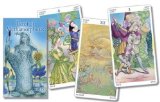
Tarot of Metamorphosis
, illustrated by Luigi Di Giammarino, companion booklet by Massimiliano Filadoro
Cards: Llewellyn Worldwide, 0738707929, 78 (+2), 2005
This deck is comprised of 78 cards (+2, an ad and a ‘cover’ card), and a little white book with explanatory text accompanies the deck. The artistic style of the deck shows a surrealist influence with a 1960s flare running through it, amongst others. Cultural references abound, with allusions to various mythologies (predominantly Greek), classic literature, and science fiction.
The trump cards often reflect common esoteric themes, though they bear little resemblance to their precursors in the Tarot de Marseille from which most modern esoteric Tarot decks descend. The accompanying booklet identifies a specific type of metamorphosis the trump card is intended to represent, such as ‘The Metamorphosis of Silence’ for the Hermit, or ‘The Metamorphosis of the Psyche’ for Temperance. The images are rich with symbolism and beauty; the Death card is particularly striking.
The suits are here termed in English (the deck and accompanying booklet offer interpretations in five languages) as Chalices, Pentacles, Wands, and Swords.
The Chalices derive their imagery from myths, depicting more idyllic or whimsical images; King Midas is reflected in the golden images of card nine, and the myth of the Minotaur is shown in the Knight of Chalices. The Pentacles show a mechanoid world, even when incorporating classical figures, such as the djinn in card eight. The Wands are placed in a more organic setting, populated with animals and elementals. The Swords are generally pseudo-Victorian in appearance, or reference popular tales, such as a Midsummer Night’s Dream in card four, Alice in Wonderland meets The Persistence of Memory in card eight, or Dorian Grey in card nine.
The booklet that accompanies the deck describes brief divinatory meanings for each card, though offers no reverse meanings, or instructions on how to interpret reverse meanings in general. It lists the specific myth or novel the images are derived form for the Chalices and Swords in brackets following the divinatory meaning, and concludes with a recommended reading list for further exploration of these themes.
The images are beautiful, but it’s not what I would call a true Tarot, as the cards bear no resemblance to the Tarot de Marseille or its predecessors. The suit cards are wholly unlike any historical decks, including the Rider-Waite-Smith deck from which many modern esoteric decks take their influence. As such, the Golden Dawn derived explanations are abandoned, and new interpretations are given, better representing the images drawn for this deck. However, it could work well as a lovely oracle deck.
The booklet also includes a unique Tarot spread, called the Chrysalis, which I tried out. While I found it challenging to connect with the images on a divinatory level, my husband was able to tease intelligible results from the cards and found it quite useful.
It can most certainly work as a divinatory deck, but as its images are more modern and culturally influenced rather than Golden Dawn derived, as most modern ‘traditional’ decks are, some may find this difficult to work with, or require some adjustments in methods of reading. On the other hand, it could be seen as a welcome breath of fresh air rather than yet another Rider-Waite-Smith clone.








